#ResourceManagement
Explore tagged Tumblr posts
Text
A Dungeon Master's Guide to Designing Fantasy World Geopolitics
Understanding the geopolitical forces at play in your fantasy world can transform it from a static backdrop into a dynamic, living entity. By applying real-world principles of geography, climate, and resource distribution, you can create plausible societies, enduring conflicts, and compelling narratives. This guide distills the insights from Baron de Rop's analysis of Faerûn to help you build a robust and believable geopolitical landscape for your own campaign setting.
Phase 1: Laying the Foundation – Climate & Geography
The physical world dictates the possibilities for life and society. Start by sketching out the fundamental geographical features of your world, considering their impact on resources.
Water is Life (and Society):
Identify Major Water Sources: Rivers, lakes, seas, and even massive glaciers are crucial.
Glacial Impact: If you have glaciers, consider their long-term effects:
Mountain Carving: Deep channels and valleys in areas below the ice.
Debris Fields: Scattered boulders and outcrops in lowlands, carried and deposited by glacial movement.
Floodplains/Bogs: Further from glacial foothills, where water accumulates.
Resource Distribution: Glaciers inform where arable land, stone, and metal ores might be easily accessed (e.g., runoff supporting fertile valleys, exposed rock formations).
Sea/Oceanic Influence:
Wind Patterns: Determine prevailing wind directions. Winds carrying moisture from oceans will drop it as rain when they hit elevated terrain.
Rain Shadows: The leeward side of mountain ranges will be arid or barren due to moisture being "wrung out" on the windward side.
Coastal Rainfall: Areas close to the coast will likely receive consistent sea-based rainfall, supporting lush growth.
Rivers and Lakes:
Fertile Land: River valleys and lake basins are often the most fertile areas, ideal for agriculture.
Transportation Arteries: Rivers provide efficient, cost-effective transport routes.
Terrain & Resources:
Mountains: Source of stone and metal ores. Act as natural barriers, influencing population movement and defense.
Forests: Provide timber for construction and fuel. Indicate areas of consistent rainfall.
Grasslands/Steppes:
Rainfall Indicators: Lack of trees or lush grass suggests arid conditions and lower rainfall.
Migratory Fauna: Consider if large herd animals (like bison or wildebeest) exist that prevent tree growth by trampling. If so, this explains why a fertile plain might remain a grassland rather than a forest.
Nomadic Lifestyles: Arid grasslands often support nomadic herding populations.
Swamps/Marshes: Impede movement and trade, making regions harder to access or develop.
Scale Matters:
Define Your Map's Scale: Understand the vastness of your regions. Is a "forest" the size of a national park or a small country? This influences travel times, resource availability, and the scope of conflicts.
Distance & Cost: Remember that overland travel is significantly more expensive than water-based transport (up to 20 times!).
Phase 2: Populating the World – Societies & Interactions
Once your geography is set, think about how different populations would emerge and interact based on these physical realities.
Cities & Settlements:
Harbor & River Mouths: Large cities often arise at defensible natural harbors or at the mouths of wide, navigable rivers, enabling trade.
Resource Access: Settlements thrive where there's easy access to essential resources: water, fertile land, timber, and building materials (stone, metal).
Strategic Locations: Consider choke points, defensible positions (e.g., mountains on two sides, flanked by water), or resource hubs.
Growth Potential: Cities with diverse resource access and good trade routes are poised for greater growth and wealth. If a prime location isn't a major city, ask "Why not?" (e.g., a historical disaster, a powerful magical threat, a societal choice).
Trade & Economy:
Water Dominance: Water-based trade is king. Settlements with river or sea access will naturally become economic hubs.
Overland Trade Routes:
Purpose: If roads exist, especially through difficult terrain, they imply a strong economic incentive (e.g., highly prized rare commodities).
Maintenance: Such roads might be remnants of fallen civilizations, or require significant ongoing investment.
Support Structures: Look for smaller settlements or outposts spaced about a day's travel apart to support caravans (like the Silk Road).
Resource Needs vs. Availability: What resources does one region have in abundance, and what do they need that another region possesses? This drives trade and potential conflict.
Security & Conflict:
Defensibility: Geography plays a massive role in a region's defensibility.
Natural Barriers: Mountains, large rivers, dense forests, or coastal cliffs can provide significant protection (e.g., Northern Italy's defensible position).
Open Plains: Flat, expansive terrain is notoriously difficult to defend and often becomes a historical "war-torn region" (e.g., Poland).
Threats from Neighbors:
Nomadic Warriors: Arid steppe regions can breed tough, mobile warriors (like the Mongols) who, when their populations grow too large for their land to support, may invade more fertile, settled areas.
Maritime Threats: Island chains or coastal populations can pose significant threats to mainland trade through piracy, privateering, or controlling sea lanes.
Strategic Control Points: Identify locations whose control gives dominion over larger regions (e.g., islands controlling a coast, or a mountain pass controlling trade).
Societal Development & Culture:
Resource Abundance & Stability: When basic needs (food, clothing, shelter) are easily met, populations can pursue higher levels of Maslow's Hierarchy of Needs, leading to cultural advancements, art, science, and luxury goods (e.g., Renaissance in Northern Italy).
Resource Scarcity & Isolation: Regions with limited resources and difficult access to broader economies may foster:
Self-Reliance & Mistrust: People are isolated and have to make everything themselves.
Tribalism & Infighting: Poverty and limited opportunities can lead to internal strife.
Lack of Education/Advancement: Without exposure to external ideas, scientific and magical advancements may be slow or non-existent.
Toughness: People from harsh environments are often hardy and formidable.
Phase 3: Refining & Injecting Fantasy
Once you have a plausible baseline, it's time to layer in the magic and fantastical elements of your world.
The "Why Not?" Question:
For every real-world geopolitical expectation you've set up, ask if your world's magic, creatures, or lore provide a compelling reason for it not to happen that way.
Example: If a rich river delta isn't a major city, is it because a powerful dragon lairs there, or a perpetual magical blight makes it uninhabitable?
Example: Are roads through a perilous mountain range maintained by magically enchanted constructs, or by a specific group whose unique abilities make it feasible?
Fantastical Influences on Geography:
Magical Storms/Climate Control: Does a powerful wizard control the weather, influencing rainfall patterns?
Elemental Rifts: Do elemental energies shape terrain in unusual ways, creating impossible mountains or perpetually burning forests?
Divine Intervention: Did a god's act create a unique resource or transform a landscape?
Racial/Creature Geopolitics:
Resource Needs: Do certain races have unique resource requirements (e.g., dwarves needing specific ores, elves needing ancient forests)?
Environmental Preferences: Do they thrive in specific biomes (e.g., drow in underground caverns, minotaurs in labyrinths)?
Natural Defenses/Advantages: Do their innate abilities (flight, burrowing, magical resistance) change their interaction with terrain?
Predatory/Prey Relationships: How do dangerous creatures affect settlement patterns and trade routes?
Historical Layers:
Fallen Civilizations: Use ancient ruins, forgotten roads, or abandoned cities to hint at past geopolitical realities that have shaped the present. What brought them down? How did their fall change the landscape of power?
Long-Term Consequences: Consider the lasting impact of major historical events on the current geopolitical map (e.g., an ancient war that left a region barren, a magical cataclysm that isolated an area).
Phase 4: Testing & Iteration
Your geopolitical map is a living document.
Ask Questions: Constantly challenge your assumptions. Why would people settle here? What would they do? What would they need? Who would they fight?
Interconnectivity: Ensure that the choices you make for one region have logical ripple effects on others. A war in one area might disrupt trade for another; a new magical discovery in a third might shift the balance of power.
Conflict Drivers: Use your geopolitical insights to generate plausible conflicts, alliances, and rivalries. Resource scarcity, trade route control, defensible borders, and historical grudges all make for compelling story hooks.
By systematically applying these geopolitical considerations, you'll create a fantasy world that feels more grounded, dynamic, and ripe for adventure, providing a solid foundation for countless campaigns. Good luck, Dungeon Masters!
The Primary Source for this paper was an amazing video mentioned in the top, linked below.
youtube
#FantasyWorldbuilding#DungeonMasterTips#TTRPG#WorldbuildingGuide#GameDesign#FantasyMaps#ttrpg community#ttrpg tumblr#homebrew#dungeons and dragons#madlabgames#dnd5e#FantasyGeopolitics#WorldLore#MapMaking#CampaignSetting#DMToolkit#PoliticalFantasy#TerrainEffects#ResourceManagement#CreateYourWorld#DMInspiration#AskTheDM#FantasyLore#Youtube
7 notes
·
View notes
Text

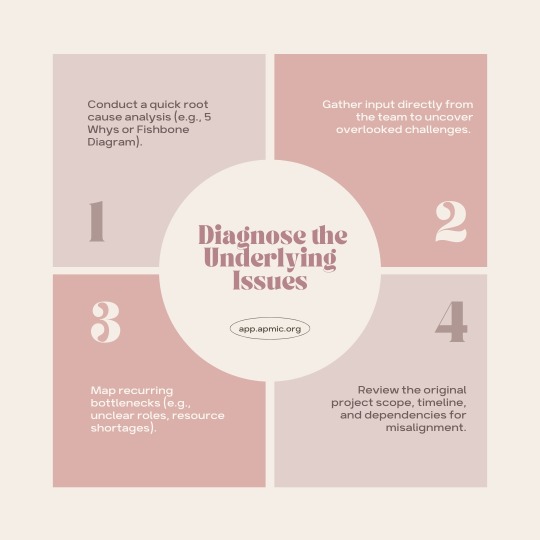






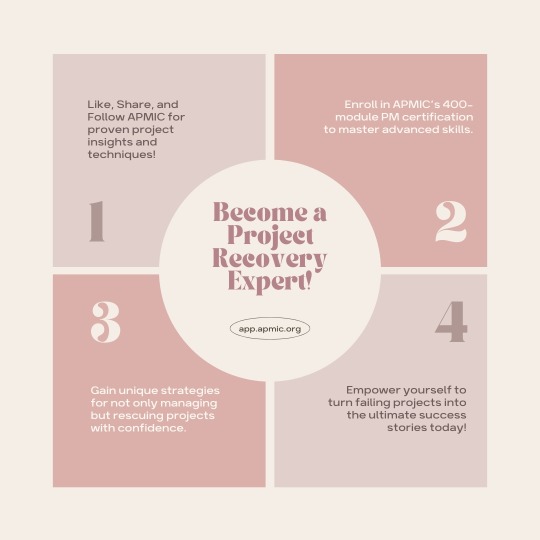

🚨 Is your project veering off course?* Don’t worry—we’ve got your back! Here are 3 simple steps to rescue a failing project:
1️⃣ Assess the situation: Identify what’s going wrong—budget overruns, scope creep, or resource shortages. Clear diagnosis = effective solutions.
2️⃣ Reprioritize and realign: Revisit your goals, timeline, and resources. Adjust the project plan and communicate changes to your team.
3️⃣ Engage the team: Collaboration is key! Motivate your team, delegate tasks effectively, and establish clear accountability.
💡 Tip: Stay proactive and maintain open communication throughout the process.
What’s your go-to strategy for saving a project in trouble? Drop your advice in the comments! ⬇️
#ProjectManagementTips#LeadershipHacks#TeamworkWins
#APMICorg#projectrescue#projectmanagement#leadershipskills#teammanagement#businessgrowth#professionaldevelopment#timemanagement#projectplanning#trainingforsuccess#workplacetraining#skillbuilding#teamcollaboration#continuouslearning#strategicthinking#careergrowth#projectleadership#goalsetting#resourcemanagement#problemsolving
1 note
·
View note
Text
How Does Resource Heatmap Optimize Profitable Utilization?

Are you constantly struggling to optimize #resourceutilization and maintain high levels of #productivity? Not anymore! A robust #resourceheatmap enables decision-makers to slice and dice data at a more granular level to identify & address over- and under-utilization and boost #employeeproductivity. 📖 Explore how a resource #heatmap can unlock better utilization.
Read More: Resource Management Software
#resourceplanning#saviom#resource-allocation-software#project management#project portfolio#resourcemanagement#software#project managers#resource management
0 notes
Text
Businesses rely on the Project Management Office (PMO) to provide strategic insights, governance and oversight to ensure project success At the heart of this function lies PMO reporting a structured approach to tracking analyzing and communicating project and portfolio performance
But what exactly is PMO reporting and why is it crucial for effective project management
In this comprehensive blog we will cover
What PMO reporting is and why it matters
Key components of an effective PMO report
Types of PMO reports
Best practices for PMO reporting
Common challenges and how to overcome them
Future trends in PMO reporting
This blog will provide you with a solid understanding of how to create reports that drive decision making and business success
#PMOReporting#ProjectManagement#PortfolioManagement#PPM#PMOTools#ProjectSuccess#StrategicExecution#DataDrivenPMO#ExecutiveReporting#RiskManagement#ResourceManagement#AgilePMO#FinancialTracking#KPIAnalysis#ProjectGovernance
0 notes
Text



The 2017 FIDIC® Red Book FÉDÉRATION INTERNATIONALE DES INGÉNIEURS-CONSEILS (FIDIC)
A Companion to the 2017 Construction Contract focuses on contractor-designed civil, mechanical, electrical, and construction works. It's a key document for understanding the 2017 edition of the Red Book, which is a standard form of contract widely used in the construction industry. This companion likely provides detailed explanations, interpretations, and practical guidance to navigate the complexities of the contract, including clauses related to contractor responsibilities and design aspects.
•Sonetra KETH (កេត សុនេត្រា) •Project Manager/Architectural Manager/BIM Director •RMIT University Vietnam + Institute of Technology of Cambodia ------------------------------------------------------------ 建筑师经理、专案经理、BIM总监 Giám đốc Kiến Trúc, Giám đốc Dựán, Giám đốc BIM
#Sonetra Keth#NETRA#នេត្រា#កេត សុនេត្រា#Project Manager#Architectural Manager#Design Manager#ProjectManagement#PMBOK#PMP#ProjectPlanner#Agile#Scrum#Kanban#Waterfall#ProjectLifeCycle#RiskManagement#StakeholderManagement#ProjectScheduling#GanttChart#WorkBreakdownStructure (WBS)#CriticalPathMethod (CPM)#ResourceManagement#ProjectTeam#ProjectGoals#TimeManagement#CostManagement#ScopeManagement#TaskManagement#ProjectTools
0 notes
Text
Stone Age

Stone Age - Bernd Brunnhofer This is a typical worker placement game that focuses on probability. Unlike many other worker placement games when you place your worker somewhere an outcome is guaranteed.Here it is not. This is only true with resource gathering.All the other locations operate as you would expect. The rounds are very quick. My version had a cool cup of leather that was stitched together for rolling the dice which gave it an ancient vibe. I'm a sucker for great game pieces like this. The concept of tools to increase the dice rolls is a great way to show your society focuses on advancement.This is at the cost of population increase or resource gathering.The same is true for agriculture. You can spend workers to develop your agricultural advancement which will make food automatically produced in later turns.The cost here is the same as for tools. There is also an interesting move where you can block the purchase of a point card by spending a worker to stand on it.This is a fairly original idea and it can make tight games more interesting. It is great that there is no clear 'best' way to play this game. A combination of technology, population, and agriculture all seem to work as well as focusing on a single one of these. The game is enjoyable but there is not much depth here so it won't be to everyone's liking. It's good for a quick pick-up and play. Read the full article
#BGGTopGames#BoardGameAddict#BoardGameCommunity#BoardGameLovers#BoardGameNight#BoardGameReview#BoardGamersUnite#CavemanCulture#EuroGame#FamilyBoardGame#GameReview#MeepleLife#ModernClassics#ResourceManagement#RollAndGather#StoneAgeGame#StoneAgeStrategy#StrategyGame#TabletopGaming#WorkerPlacement
0 notes
Text
Introduction: 🚀 Level Up Your Productivity: A League of Legends Inspired Guide

Welcome to "Level Up Your Productivity: A League of Legends Inspired Guide"! 🎮 Are you ready to unlock the secret strategies that will help you conquer both the virtual battlegrounds of League of Legends (the world of Arcane is based on this game) and the challenges of your everyday life? 🌟 Join us on this epic journey as we bridge the gap between gaming and productivity to supercharge your success!

🤔 How can a game like League of Legends ignite your productivity to new heights? Have you ever wondered how gaming principles can translate into real-life achievements? Let's embark on a quest to find out! 🔍 Are you seeking ways to level up your productivity and achieve your goals with greater efficiency? Are you ready to tap into the wisdom of the gaming world and apply it to your everyday tasks? Comment "yes" if you're ready to unlock your true potential!

- ⚡ Unlocking the Nexus of Productivity: In this blog post series, we'll unveil the hidden parallels between the strategic world of League of Legends and the realm of productivity. 🌐 Discover how skills like strategic thinking, decision-making, teamwork, and resource management in the game can be harnessed to conquer your personal and professional challenges. 🤔 Can you imagine applying gaming tactics to overcome productivity obstacles in your life? Are you ready to harness the power of gaming strategies to level up your productivity game?

- 🎯 Goal-Setting for Success: We will explore the importance of setting clear goals, both in League of Legends and in life. Learn how to establish objectives, break them down into actionable steps, and stay motivated on your journey to success. 🔍 Are you struggling to define your goals and stay focused on them? Do you crave a roadmap to guide your progress and keep you motivated? Comment "yes" if you're ready to transform your aspirations into tangible achievements!

- 🤝 Harnessing the Power of Teamwork: Teamwork makes the dream work, whether you're on the Summoner's Rift or collaborating in a professional setting. 🙌 We shall discover the secrets to effective communication, cooperation, and synergy that lead to victory both in-game and in your daily endeavors. 🤔 Do you find it challenging to work effectively with others and achieve common objectives? Are you ready to unlock the power of teamwork and build productive alliances? Comment "yes" if you're eager to amplify your collective success!

Conclusion:
Get ready to embark on an extraordinary adventure where gaming meets productivity! 🌟 In this blog series, we'll equip you with invaluable insights, practical strategies, and engaging gameplay-inspired approaches to level up your productivity game. 🚀 Stay tuned for the upcoming posts, where we'll explore role-specific techniques, champion-inspired tactics, effective communication, workflow optimization, and cultivating a growth mindset. 🔑 Are you ready to seize the opportunity to become a productivity champion both in and out of the gaming realm? Say "yes" if you're eager to join us on this transformative journey! Read the full article
#decision-making#Gaming#gaminginspiration#Goal-setting#LeagueofLegends#nicopengin#personaldevelopment#productivity#productivityhacks#productivityingaming#productivityinlife#productivityinspiration#productivityjourney#productivitymindset#productivitystrategies#productivitytips#professionaldevelopment#resourcemanagement#self-improvement#strategicthinking#Teamwork
0 notes
Text





Simple Logic's Expertise Transformed a Leading Enterprise's PostgreSQL System Performance!
Challenges: 🚨 Frequent FDW process failures, impacting system reliability 📉 Resource crunch due to server limitations 🕒 Delays causing customer dissatisfaction and operational inefficiencies
Our Solution: �� Migrated the database to AWS for enhanced scalability and reliability 🔗 Optimized PostgreSQL Foreign Data Wrapper (FDW) connectivity for seamless functionality ⚡ Resolved resource management issues with a robust new server
The Results: ☁️ Successful FDW configuration in the AWS Cloud 💨 Improved database performance and faster processing speeds 📊 Enhanced resource management and system reliability
Transform your business operations with Simple Logic’s cutting-edge database solutions! 🚀
💻 Explore insights on the latest in #technology on our Blog Page 👉 https://simplelogic-it.com/blogs/
🚀 Ready for your next career move? Check out our #careers page for exciting opportunities 👉 https://simplelogic-it.com/careers/
👉 Contact us here: https://simplelogic-it.com/contact-us/
#DatabaseOptimization#PostgreSQLSolutions#AWS#Cloud#AWSCloud#Data#Database#DatabasePerformance#ResourceManagement#SystemReliability#PostgreSQL#SimpleLogicIT#MakingITSimple#MakeITSimple#SimpleLogic#ITServices#ITConsulting
0 notes
Text
Sustaining the Commons: Policy Strategies for Effective Management of Shared Natural Resources
Shared natural resources face challenges like overuse, inequitable access, and climate change. Effective policy strategies—community-based management, market regulations, technology-driven governance, and global cooperation—are key to sustainability. Aspiring policymakers must develop expertise in governance, data analysis, and conflict resolution through formal education to drive impactful solutions for resource conservation and equitable access.
#PublicPolicy#Sustainability#ResourceManagement#GoverningTheCommons#EnvironmentalPolicy#ClimateAction#CommunityGovernance#PolicyInnovation#AIForSustainability#SustainableDevelopment
0 notes
Text
Sustainable Development Course |00201010232279
Sustainable Development Course 🌍♻️
📍Istanbul — May 26–28, 2025
🎓Course Overview:
With increasing environmental and social challenges, sustainable development has become essential for ensuring a prosperous future. This course aims to enhance participants’ understanding of sustainable development concepts and applications.
📚Course Topics:
Fundamental Concepts: Understanding the Sustainable Development Goals (SDGs) and their importance.
Practical Strategies: How to integrate sustainability principles into organizational policies.
Resource Management: Developing plans to manage resources efficiently and responsibly.
Case Studies: Analyzing successful examples of sustainability applications in various organizations.
Target Audience: Individuals interested in sustainable development, project managers, corporate social responsibility officers, and anyone aiming to contribute to a sustainable future.
— — — — — — — — — — —
For more information, contact us now:
📲 00201010232279
🔗 https://wa.me/201010232279
#التنمية_المستدامة #SustainableDevelopment
#أهداف_التنمية_المستدامة #SDGs
#الاستدامة #sustainability
#إسطنبول #istanbul
#دورةتدريبية #trainingcourses
#البيئة #environment
#المسؤولية_الاجتماعية #socialresponsibility
#إدارة_الموارد #resourcemanagement
#استراتيجيات_الاستدامة #SustainabilityStrategies
#مستقبل_مستدام #SustainableFuture

#التنمية_المستدامة#SustainableDevelopment#أهداف_التنمية_المستدامة#SDGs#الاستدامة#sustainability#إسطنبول#istanbul#دورةتدريبية#trainingcourses#البيئة#environment#المسؤولية_الاجتماعية#socialresponsibility#إدارة_الموارد#resourcemanagement#استراتيجيات_الاستدامة#SustainabilityStrategies#مستقبل_مستدام#SustainableFuture
0 notes
Text
Introduction To P6 Scheduling: Key Concepts And Terminology
This Guide Provides An Overview Of Essential Keywords And Concepts In Primavera P6 Scheduling. Learn About Critical Path Method (CPM), Work Breakdown Structure (WBS), Float, Baselines, Constraints, And Earned Value Management (EVM). Understand How P6 Helps In Project Planning, Resource Allocation, And Schedule Optimization For Successful Project Management.
#P6Scheduling#PrimaveraP6#ProjectManagement#CriticalPathMethod#WorkBreakdownStructure#Baseline#ProjectPlanning#ConstructionScheduling#EarnedValueManagement#SchedulingTechniques#ResourceManagement#ProjectControls#GanttChart#ProjectTimeline#ScheduleOptimization#PMSoftware
0 notes
Text

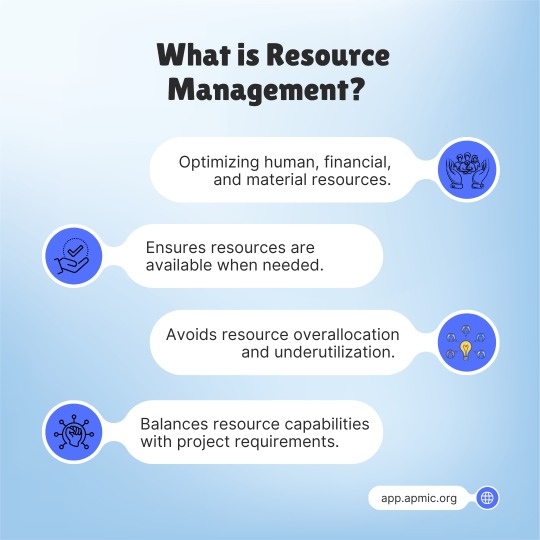
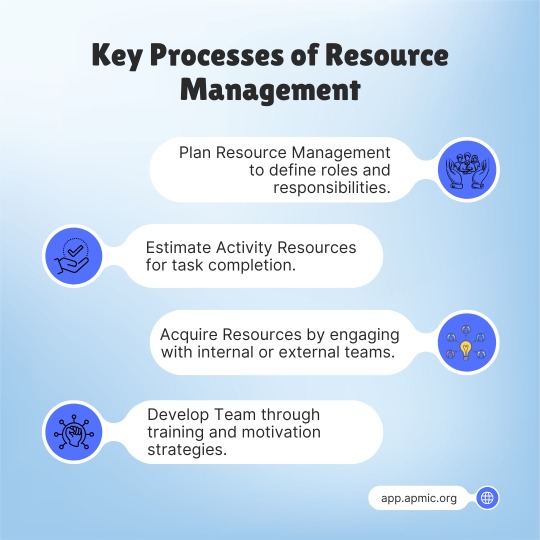





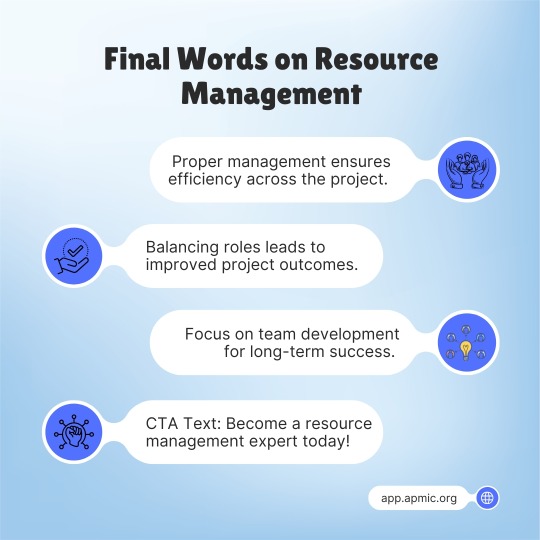

📌 Mastering Project Resource Management! 🚀
Efficient Resource Management ensures the right people, funds, and tools are available when needed—boosting productivity and preventing burnout. Here’s how:
✅ Plan Resource Management – Define roles & responsibilities.
✅ Estimate & Acquire Resources – Assign the right people for the right tasks.
✅ Develop & Manage Teams – Train, motivate, and optimize performance.
✅ Control & Balance Resources – Avoid overload & ensure smooth workflows.
🔹 Tools for Success: RACI Charts, RAM, Time Tracking, Resource Leveling.
🔹 Avoid pitfalls: Undefined roles, uneven workloads & scheduling conflicts.
🔹 Pro tip: Conduct resource planning workshops & use skill-based assignments!
🌐 Visit: app.apmic.org
💡 Master these skills & lead projects like a pro! 💼✨
#projectmanagement#resourcemanagement#PMI#leadership#productivity#projectsuccess#agile#scrum#PMO#projectleadership#strategicplanning#efficiency#riskmanagement#teamdevelopment#managementtips#pmcertification#businesssuccess#projectplanning#workflowoptimization#professionalgrowth#resourceallocation#PMP#taskmanagement#workforceplanning#careersuccess#resourcestrategy
0 notes
Text
#united states#TimeTracking#ProjectManagement#BudgetOptimization#DeadlineManagement#Productivity#WorkEfficiency#Automation#ResourceManagement
0 notes
Text
7 Effective Strategies to Avoid Scope Creep in Project Management

🚨 Scope Creep is more common than you think! And, if left unchecked, it can quickly derail timelines and inflate costs, turning even the best-planned projects into a challenge. ⏳💰 But don’t worry! With the right strategies, you can keep scope creep in check and ensure smooth #projectexecution. ✅ Check out our latest blog for #experttips on preventing scope creep! 🚀🔗
Read More: Resource Management Software
#project portfolio#resource management#saviom#resourceplanning#software#resource-allocation-software#resourcemanagement#project management#resource-management-software
0 notes
Text
Effective project management is more than just meeting deadlines. It is about ensuring projects are completed within scope, on time,quality and within budget while aligning with strategic goals. This is where Clarity, formerly known as CA Clarity PPM becomes a game-changer. Clarity is not just another project management tool; it is a robust platform designed to empower organizations with the visibility and control needed to successfully manage and deliver projects, programs, and portfolios.
This blog will explore how Clarity supports successful project management delivery, its flexibility for different project sizes, and how it seamlessly integrates with various project management methodologies. By the end of this post, you will understand why Clarity is a preferred choice for organizations seeking structured, scalable, and strategic project execution.
#ProjectManagement#ClarityPPM#PortfolioManagement#AgileDelivery#WaterfallProjects#HybridProjectManagement#ResourceManagement#StrategicPlanning#ProjectSuccess#EnterpriseSoftware#PMOTools#DigitalTransformation#BusinessAgility#ITGovernance#ProjectExecution
0 notes
Text
How Mines Survey Helps in Mineral Exploration and Resource Management

The mining industry relies so much on getting the correct data in the right conditions for locating mineral deposits and managing them effectively. Surveying is a critical input here in this process, as it offers the necessary measurements and mapping information for exploration, planning, and extraction. Companies, for example, Dolphin Engineers, contribute to this field by offering reliable surveying solutions to aid in optimizing mining operations.
The Role of Mines Survey in Mineral Exploration
Mineral exploration is the first step in any mining operation. Before extraction begins, surveyors assess the land to determine the presence of valuable minerals. Advanced surveying techniques help geologists and engineers analyze terrain, estimate deposit sizes, and evaluate the feasibility of mining activities.
Modern surveying tools, including GPS, drones, and LiDAR technology, allow for high-accuracy data collection. Mining companies can then make informed decisions based on the data. Dolphin Engineers specialize in using these technologies to provide precise geological and topographical information. Their expertise ensures that exploration activities are conducted efficiently, reducing unnecessary expenses and environmental disruption.
Accurate Mapping and Data Collection
A well-conducted survey provides detailed maps that are crucial for planning mining operations. These maps outline mineral-rich zones, geological structures, and potential hazards, helping engineers design efficient extraction plans.
Mine surveyors use remote sensing and geophysical survey techniques to measure dimensions and depths of ore bodies. This information plays an essential role in optimizing drilling locations and minimizing waste. Dolphin Engineers excels as a producer of accurate mapping solutions that advance mining operations, providing maximum output at minimal risk.
Resource Management and Sustainability
The efficiency of resource use is key in extending the mine's lifespan while minimizing impacts on the environment. Surveying can be helpful in monitoring depletion, controlling waste disposal, and planning rehabilitation.
Regular mine surveys track excavation progress, providing data on the amount of material extracted and that which remains. This continuous assessment keeps mining activities within regulatory limits and ensures that resources are used responsibly. Companies like Dolphin Engineers provide the line of monitoring solutions that can help keep the mining activities within compliance levels of environmental and safety standards.
Safety and Risk Mitigation
Mining operations are hazardous and involve potential risks such as land subsidence, rockfalls, and structural failures. In this regard, surveying plays a crucial role in identifying all the potential hazards before they reach critical levels.
Geotechnical monitoring, slope stability analysis, and underground mapping enable mine operators to take pre-emptive measures. There is a minimum chance of accidents and the mine infrastructure remains stable with accurate surveys. Dolphin Engineers provides specialized safety assessment services, ensuring that mines maintain secure work environments.
Recent Technological Improvements in Mine Surveying
With the advancement of cutting-edge technology, mine surveying has developed greatly. High-resolution cameras on drones along with LiDAR sensors create high-definition 3D models of mining sites. Satellite imagery and geospatial analysis improve the planning and monitoring of mining activities.
This in itself has improved efficiency in surveying, reducing human error and increasing productivity. Dolphin Engineers remains at the forefront of this advancement, maintaining the latest innovations to support the mining industry.
Conclusion
Mines surveying is an indispensable element of mineral exploration and resource management. This in itself ensures proper data accumulation, supports efficient mining, and promotes sustainable resources utilization. Companies such as Dolphin Engineers keep the mining sector abreast with the latest innovations in surveying technology, bringing about more precise, reliable, and safe ways of exploration in the industry. Advanced surveying techniques help to improve efficiency within mining companies in a way that is not just safe and clean but also responsibly productive.
#dolphinengineers#Mining#MineSurveying#MineralExploration#SurveyingTechnology#GeospatialMapping#LiDAR#DronesInMining#ResourceManagement#SustainableMining#MiningSafety#GeotechnicalSurvey#MiningInnovation#TopographicalMapping#MiningIndustry#MiningSolutions
0 notes